【New infrastructure for ultra-high voltage series 2 of 3】 Combination of Smart Meter and Wi-SUN communication module
AMI-Application of Smart Meter
Advanced Metering Infrastructure (AMI) is the core infrastructure for the development of smart grids; AMI with networking capability can display information in real-time, allowing users and the power company to grasp the power usage status of the region and perform optimization management according to usage scenarios. Users can view the data recorded by the meter from mobile APP or the computer and adjust the usage of appliances to reduce unnecessary expenditures, and they can perform safety monitoring for power usage of their homes while at work or outdoors. Power company personnel can use remote viewing to check whether the status is normal, and the accumulated data can be applied in Big Data to analyze the power usage of each region to find the most suitable energy-saving and power dispatch solutions. It is an important and indispensable infrastructure for the pushing of both demand response and energy management.
The composition of AMI can be divided into several parts: 1. Smart meter, 2. Communication system and 3. Meter management system. The power usage data measured by the smart meter is transmitted to the communication system using wired or wireless methods, the communication system will integrate the data reported by all meters in that region and then send it to the meter management system for analysis and management. Now let’s explore smart meters further. Countries around the world refer to the mainstream U.S. (ANSI C12) and European (IEC 62056) standards and make modifications according to local usage situations. The design of new generation meters mostly adopts the use of both metrology and management modules; the metrology module is responsible for measurement, information display (LCD), data storage, and status report. The management module is also referred to as the communication module; it uses various wireless transmission methods through programmable logic controllers (PLC) and Ethernet etc. to act as a communication bridge to transmit the data from the metrology module to regional communication systems and to receive messages. It can reduce the need for a manual reading of meters significantly. Communications between the metrology module and management module are performed through standard communication interfaces such as SPI and UART etc. As mentioned at the beginning of the article, even though smart meters with networking capabilities can bring many benefits, the completeness of its security mechanism and the privacy of users after it was implemented are still directions that the meter manufacturers and power companies are working on.
NuMicro M2351 Smart Meter Reference Design
We collaborated with Security Platform Inc. (SPI) in Korea and launched the next generation AMI2.0; Nuvoton’s M2351 series microcontrollers were used in combination with the Arm® Mbed™ OS for the communication module. Its functions not only comply with the DLMS1* secure communication requirements but it also further realized a complete security function solution that we will explain below:
- Secure communication
SPI Smart-meter is based on the (D)TLS1.2 secure connection mechanism; when a connection is initiated, the supported connection version and encryption algorithm are explained first, and then certification exchange is further performed to confirm whether the object transmitting the message is a trusted party; finally, encrypted communication will be performed after the key exchange has completed. Nuvoton provides complete hardware encryption/decryption engines (AES, 3DES, HAMC, ECC, SHA, and TRNG) as an aid to reduce resource usage for the CPU and allow the meters to focus on data transmission and processing; related hardware resources are set in the secure area in the microcontroller to prevent illegal inquiries of non-secure areas.
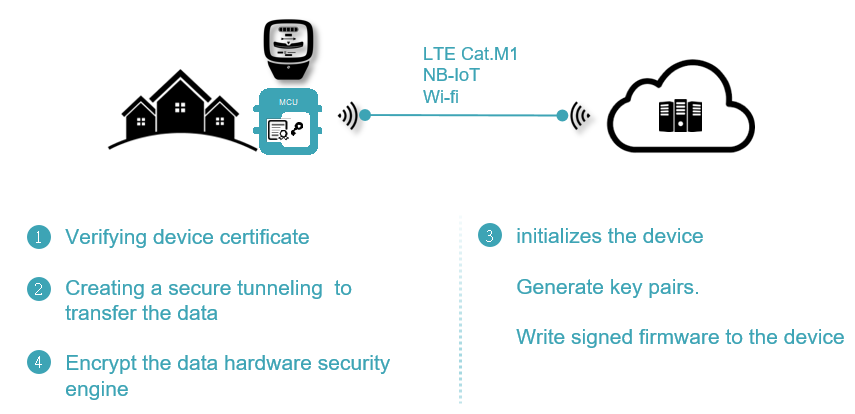
- Secure boot
Built on TrustZone technology, SPI and Nuvoton provide a set of secure boot check mechanism/program code (Trust boot code) that is placed in a secure area that cannot be modified. Every time the system boots up, the validity of the firmware to run will first be confirmed by verifying the HASH value and digital signature (ECDSA) of the firmware to check its authenticity and validity; it will go to this area to execute the program only after the test has been completed. This practice can ensure that the meter has not been tampered with maliciously or have third-party programs implanted for illegal behaviors such as stealing confidential information or stealing electricity etc. The following process explains how SPI generates the security certificate needed for Secure boot.
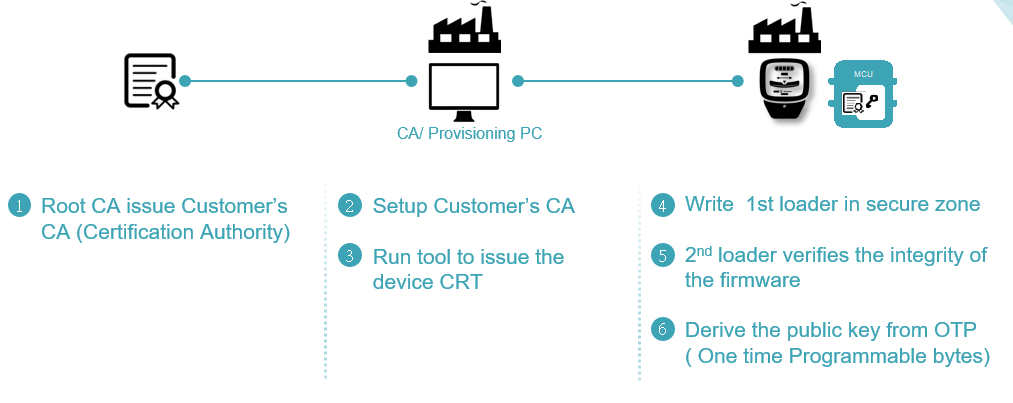
- Secure update
The advantage of smart meters is that firmware updates can be performed through OTA. SPI provides multiple wireless transmission interfaces (LTE, CAT.M1, NB-IoT, and Wi-Fi) and the internal Flash of Nuvoton’s M2351 supports the Dual-Bank function; after the meter verifies the authenticity and validity of the new firmware, an update can be completed without affecting operations. SPI also implemented the Anti-rollback protection mechanism to ensure that the firmware will not be overwritten by older versions to prevent the generation of security loopholes.
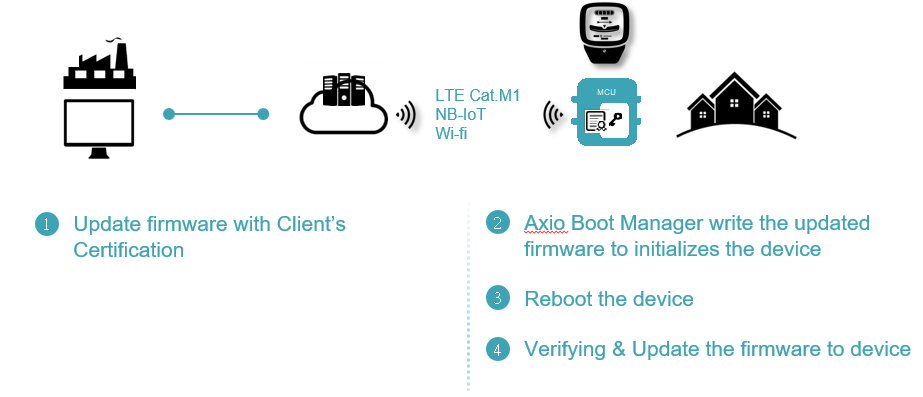
In the operation life cycle of smart meters, security threats can appear in different forms. The next generation smart meter solution launched by SPI passed PSA Certified™ Level 1 OEM certification in October of 2019; through the Arm Pelion IoT platform supports needed for the life cycle of the meter including the deployment of digital certificates, trusted update source and secure communication protocols (TLS), are all integrated with the equipment management and access control capabilities of the Arm Pelion IoT platform. Nuvoton is currently developing next-generation products actively to provide more complete software and hardware capabilities to help smart meter manufacturers reach higher levels of security protection.
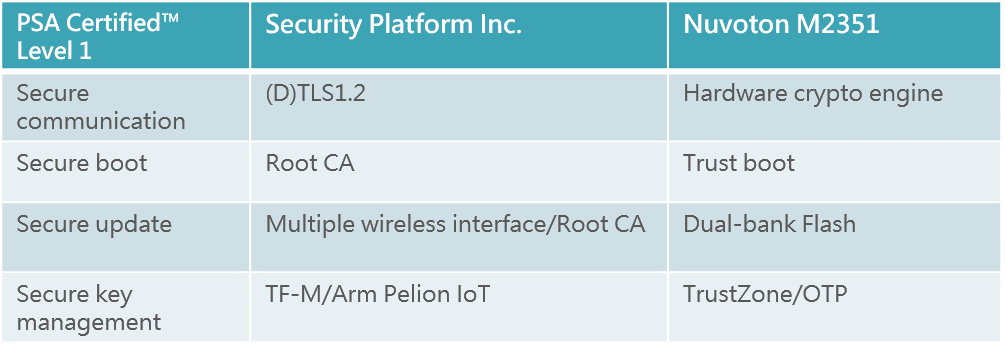
Wi-SUN Smart Meter reference design based on NuMicro® M2354
Recently, applications of related protocols based on IEEE 802.15.4 are still expected to grow, especially the utilization of Wi-SUN in certain public utility projects. In terms of application, according to the data of the market survey, the main application fields include Smart Home, Medical Devices, Auto Metering, Smart Building, and Industrial fields.
As a developer of secure microcontrollers, Nuvoton developed the NuMicro®M2354 based on our existing M2351 that is expected to be officially launched by the end of 2020. It mainly added high capacity memory and enhanced the anti-hacking capability at the chip-level, including anti-side channel attacks of cryptographic hardware and protection against various fault inject (e.g. voltage glitch and clock glitch) attacks, as well as Secure Storage with Active Shield Countermeasures in chip die level, etc. There are also existing TrustZone® and XOM functions that can be provided, so the communication protocol level can be placed in the secure area or XOM (eXecute-Only Memory) according to the program development plans. If the Transceiver IC of the RF front end includes MAC layer pre-processing (ROM-based MAC firmware and MAC Co-processor), the M2354 will be more than enough for the processing of the MAC layer post-processing and its top IP layer and above, including the application layer. It can realize the innovation of wireless transmission data based on Wi-SUN and achieve approximately doubled transmission distance compared to other average solutions while having ultra-low power consumption performances. In other words, it can provide longer battery usage time for devices that use batteries for power supply. Furthermore, no additional microcontroller that focuses on the processing of wireless communication protocol is needed; the entire reference design module includes two main chips that can fully handle the requirements for the communication and end-product designs; for example IoT applications such as wireless meter reading, remote surveillance, smart home, smart factory, and smart building, etc.
We used the following diagram below to explain the software architecture that can implement the Wi-SUN communication protocol (Wi-SUN Stack) on M2351/M2354 and complies with Arm PSA Level 2 (Planned to be certified in 2020, Q2) certification:
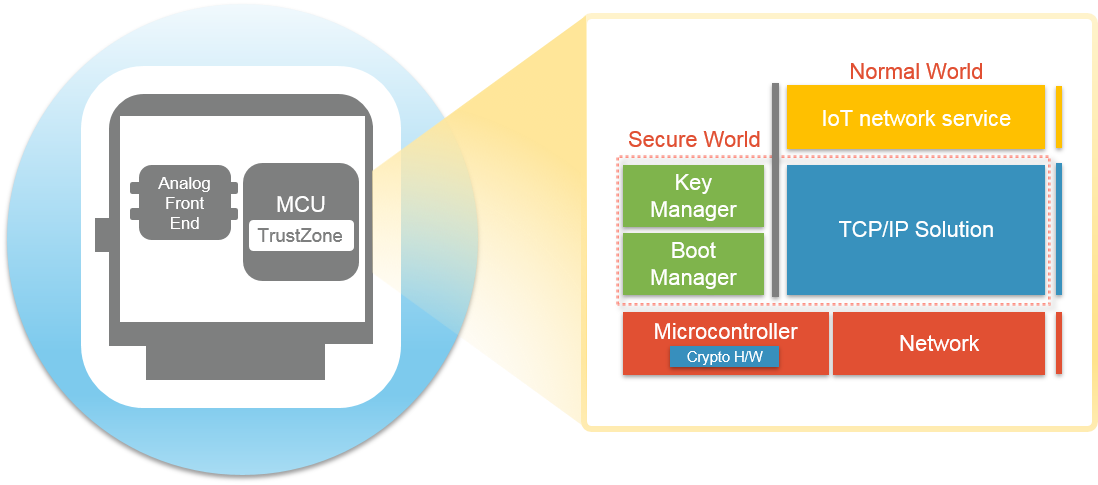
From the figure above, we can see that smart meter developers can port the Wi-SUN communication protocol onto M2354; since there are sufficient resources, M2354 can even run upper-layer applications and even RTOS. These upper-layer applications or RTOS can be placed into the non-secure area outside of the TrustZone® to fully utilize the features of Arm®v8-M and guarantee software security for internet-connected applications.
Finally, we will again explain and stress the benefits that the NuSMP (NuMicro® Secure Microcontroller Platform), which Nuvoton is currently continually promoting, can bring for application developers in the market. Currently, we have integrated software/hardware mechanisms to provide system developers with a series of complete tools they can use; this includes the following:
- Important assets of system developers can be stored securely in the microcontroller and not be stolen
- Corresponding protection mechanisms can be provided for potential security threats
- Potential security risks that system developers may generate in hardware and software designs can be avoided
- Significantly reduces barriers to entry using Arm®v8-M TrustZone® microcontrollers